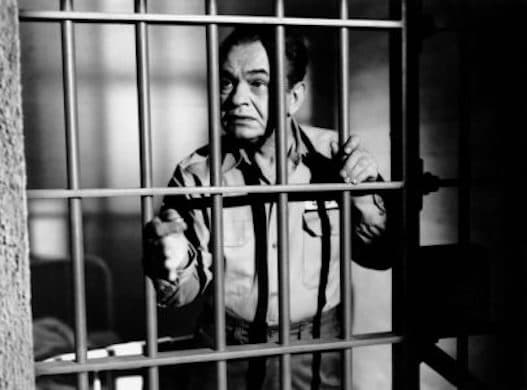MoMA Does Cinephiles a Favor With ‘Hugo Fregonese: Man on the Run’
A two-week program of 11 of the underappreciated director’s films promises ‘claustrophobia, entrapment, and imprisonment.’ Film noir devotees may want to sit up and take note.

Where does Hugo Fregonese (1908-87) fit into the auteur theory of filmmaking? Having long since misplaced my tattered copy of Andrew Sarris’s “The American Cinema: Directors and Directions 1929–1968,” I can’t recall if Fregonese made the cut, even as a footnote. The critic and historian David Thomson gives him two paragraphs in “The New Biographical Dictionary of Film,” wherein he is compared to fellow Argentinian Jorge Luis Borges and B-movie perennial Edward G. Ulmer. A cursory internet search culls only modest results.
The Museum of Modern Art, then, is doing cinephiles a favor by mounting “Hugo Fregonese: Man on the Run,” a two-week program of 11 of his films organized in conjunction with Bologna’s Il Cinema Ritrovato. The title refers not only to Fregonese’s globe-hopping — he worked in Hollywood, Berlin, Rome, London, and other locales — but also to the tenor of his pictures. MoMA promises “claustrophobia, entrapment, and imprisonment.” Devotees of film noir and others with an existential bent may want to sit up and take note.
Lest you worry that Fregonese is a marginal figure over-hyped by movie nerds out to settle a score, as happens, be aware that studio bigwigs entrusted him with stars on the level of James Mason, Louis Jordan, Joel McCrea, and Anne Bancroft. Fregonese was not a fly-by-night hack or a cult-ready oddball. His vision was consistent, distinctive, and sharp whether it was applied to the vagaries of the Old West, the randy moralism of Boccaccio, or “Man in the Attic,” a remake of “The Lodger,” Alfred Hitchcock’s silent take on Jack-the-Ripper.
The centerpiece of “Man on the Run” is “Black Tuesday,” a scruffy jailbreak movie from 1954. If the title rings a bell, that’s likely because of its lead, the inimitable Edward G. Robinson. By mid-century, the star of “Double Indemnity,” “Key Largo,” and “Scarlet Street” was, if not past his prime, then out to prove his creative vitality. How else to explain the bristling vigor a 60-something Robinson brought to his portrayal of Vincent Canelli, a gangster with zero tolerance for anyone or anything standing in his way?
The character might sound par for Robinson’s course, but Canelli was a daring choice for an actor who was, at that point, an elder statesman of sound film. Robinson gives his all in a performance that was meant to convince, not endear. Although the swagger brought to “Black Tuesday” does recall his star-making turn as Rico Bandello in “Little Caesar,” Canelli is a less palatable character if only because he’s been empowered by a cynicism that only experience can foster. Canelli’s ruthlessness tests even the regard of his associates. Robinson relishes every ugly moment of it.
Then again, what would Robinson’s performance be without the brute dynamics of Fregonese’s filmmaking? In the initial shot we see the prison in which Canelli is held, a fortress so labyrinthian it would’ve made Piranesi blanch. Once the camera takes us inside, it pans along a set of prison cells, highlighting a scowling handful of solitary inmates. After we’ve run the gamut, an African-American prisoner begins to sing; another bellows at him to shut up. Roll the titles. It’s an abrupt beginning to a story that doesn’t much let up afterward.
In a plot development that begs some credulity, Canelli manages a jailbreak seconds before he’s about to take a seat in the electric chair. One of his goons has been posing as an attending reporter, you see, and with the help of a crooked guard not only manages to prevent Canelli’s execution but those of his peers as well. Among the latter is Peter Manning (Peter Graves), a stalwart inmate who’s squirreled away $200,000 that Canelli wants his hands on. The escape isn’t without hitches: Gunplay ensues and Manning is injured.
The latter portion of the movie takes place in Canelli’s hideout, an abandoned industrial complex that’s a kaleidoscopic accumulation of stairways and corridors. The cache of money is retrieved, and the requisite test of wills ensues between an increasingly dyspeptic Canelli, his moll (a silky Jean Parker), Manning, and a handful of hostages, including the prison chaplain. A streak of anti-religious fervor on Canelli’s part further alienates the members of his gang.
Fregonese employs teetering angles throughout the denouement, and cinematographer Stanley Cortez endows the lot with a sooty tactility. Even within the parameters of the noir canon, “Black Tuesday” is notable for the bleakness of its parameters. MoMA’s “Man on the Run” should do much to elevate the film’s stature and help place its peripatetic director more firmly on the map.

